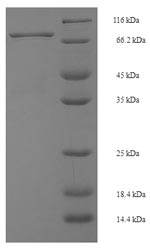In the production of recombinant Mouse Irf5 protein, the gene for Irf5 (E.coli) was cloned into a vector and expressed as Irf5 protein in E.coli. The plasmids with the copy of Irf5, or the expression vector, were often used to enhance gene expression. Every step of production was undergone with a strict QC system. N-terminal 6xHis-SUMO tag was used in the process. The purity is 90% determined by SDS-PAGE.
IRF5 is the member of the interferon-regulatory factor (IRF) family, has diverse activities, such as the activation of genes encoding type I interferon, inflammatory cytokines (including tumor necrosis factor, IL-6, IL-12 and IL-23) and tumor suppressors. IRF5 is constitutively expressed in lymphoid tissues such as spleen and peripheral blood lymphocytes. In the latter, the expression of IRF5 is mainly found in B cells and barely in T cells and natural killer cells. Higher level of IRF5 expression has been found in other immune cells such as monocytes and macrophages but relatively lower in dendritic cells. Irf5-deficient mice are resistant to lethal endotoxic shock. Researches implied that IRF5 expression in macrophages was reversibly induced by inflammatory stimuli and contributed to the plasticity of macrophage polarization. High expression of IRF5 was characteristic of M1 macrophages, in which it directly activated transcription of the genes encoding interleukin 12 subunit p40 (IL-12p40), IL-12p35 and IL-23p19 and repressed the gene encoding IL-10. Consequently, those macrophages set up the environment for a potent T helper type 1 (TH1)-TH17 response.




